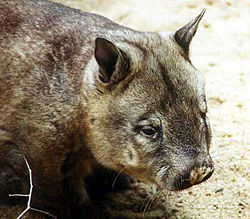Threats
Originally there were two main groups of hairy-nosed wombats (the other being the Southern hairy-nosed wombat, Lasiorhinus latifrons) that were separated by Spencer Gulf in South Australia. Both species experienced a population decline between 1870 and 1920, with the main influences being culling by agriculturalists, competition for food with introduced and feral species and predation. Threats to the northern hairy-nosed wombat include small population size, predation, competition for food, disease, floods, droughts, wildfires, and habitat loss. Its small, highly localised population makes the species especially vulnerable to natural disasters. [20] Wild dogs are the wombat's primary predator, but the spread of invasive herbivores such as the European rabbit and the actions of landowners have also contributed to their decline. [21]
There have been two reports of male northern hairy-nosed wombats contracting a fungal infection caused by Emmonsia parva , a soil saprophytic fungus. It is likely that the northern hairy-nosed wombats are inhaling the infection from the soil. [22]
Counter-measures
Since around 1993, the Queensland Government's Department of Environment and Science (DES) and predecessors have led a recovery program, supported by Glencore mining company and The Wombat Foundation, for the species. [23]
To combat the vulnerability of this species, a number of conservation projects have been put into action in the 21st century. One example was the construction of a two-metre-high, predator-proof fence around 20-kilometre (12 mi) of the park in 2000. [3] A second, insurance colony of this species of wombat was established at Richard Underwood Nature Refuge (RUNR) at Yarran Downs, near St George in southern Queensland in 2008. The reserve is surrounded by a predator-proof fence. [24] In 2021 the Australian Wildlife Conservancy (AWC), a private conservation organisation, formed a partnership with DES to collaborate on research and management of the animals in the sanctuary. In October 2023 AWC signed an agreement with DES to care for the wombats in the 130-hectare (320-acre) Richard Underwood Nature Reserve. DES would focus on the Epping Forest population. [23]
In 2006, researchers performed a study to analyse the demography of the northern hairy-nosed wombat, by using double-sided tape in the burrows to collect hair of the wombats. Through DNA analysis, they found that the ratio of female to male wombats was 1:2.25 in the population of approximately 113 wombats. These findings allowed researchers to understand the demographics of this species, and opened up further research to better understand why there is a significant difference in males and females in the wild. [15]
Within Epping Forest National Park, increased attention and funds have been given for wombat research and population monitoring, fire management, maintenance of the predator-proof fence, general management, and control of predators and competitors, and elimination of invasive plant species. [25] In addition, the species recovery plan of 2004 to 2008 included communication and community involvement in saving the species, and worked to increase the current population in the wild, established other populations within the wombat's historical range. There is also a volunteer caretaker program, that allows volunteers to contribute in monitoring the population and keeping the predator fence in good repair. In addition, DNA fingerprint identification of wombat hairs allows research to be conducted without an invasive trapping or radio-tracking program. [26]
Studies have also been conducted to assess diet [27] and nutrition. [28]
Population increases
Due to the combined efforts of these forces, the northern hairy-nosed wombat population has been slowly making a comeback. [29]
- After having been considered extinct, a population of about 30 was discovered in the Epping Forest in the 1930s, [11] and only 35 individuals were counted in the early 1980s. [12]
- In 2003, the total population consisted of 113 individuals, including only around 30 breeding females. [30]
- In the last census taken in 2013, the estimated population was 196 individuals, with an additional 9 individuals at RUNR at Yarran Downs. [31]
- In 2016 the population was estimated to be 250 individuals. [31]
- In May 2021, researchers found that the population had increased to over 300 individuals. [10] [32]
- In June 2024, the total population was reported as being over 400 individuals, including 18 at the RUNR, and 15 newly translocated to the Powrunna State Forest. [13]



